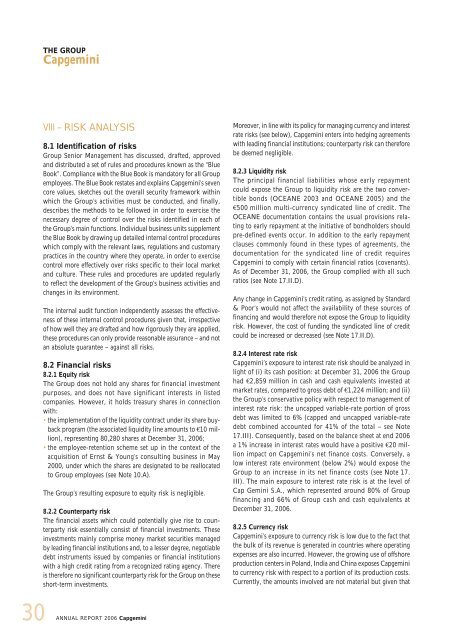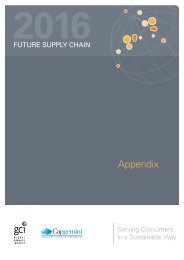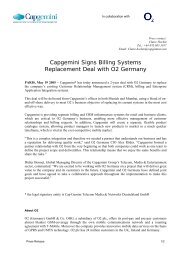You also want an ePaper? Increase the reach of your titles
YUMPU automatically turns print PDFs into web optimized ePapers that Google loves.
30 ANNUAL<br />
THE GROUP<br />
<strong>Capgemini</strong><br />
VIII – RISK ANALYSIS<br />
8.1 Identification of risks<br />
Group Senior Management has discussed, drafted, approved<br />
and distributed a set of rules and procedures known as the “Blue<br />
Book”. Compliance with the Blue Book is mandatory for all Group<br />
employees. The Blue Book restates and explains <strong>Capgemini</strong>’s seven<br />
core values, sketches out the overall security framework within<br />
which the Group’s activities must be conducted, and finally,<br />
describes the methods to be followed in order to exercise the<br />
necessary degree of control over the risks identified in each of<br />
the Group’s main functions. Individual business units supplement<br />
the Blue Book by drawing up detailed internal control procedures<br />
which comply with the relevant laws, regulations and customary<br />
practices in the country where they operate, in order to exercise<br />
control more effectively over risks specific to their local market<br />
and culture. These rules and procedures are updated regularly<br />
to reflect the development of the Group’s business activities and<br />
changes in its environment.<br />
The internal audit function independently assesses the effectiveness<br />
of these internal control procedures given that, irrespective<br />
of how well they are drafted and how rigorously they are applied,<br />
these procedures can only provide reasonable assurance – and not<br />
an absolute guarantee – against all risks.<br />
8.2 Financial risks<br />
8.2.1 Equity risk<br />
The Group does not hold any shares for financial investment<br />
purposes, and does not have significant interests in listed<br />
companies. However, it holds treasury shares in connection<br />
with:<br />
the implementation of the liquidity contract under its share buyback<br />
program (the associated liquidity line amounts to €10 million),<br />
representing 80,280 shares at December 31, 2006;<br />
the employee-retention scheme set up in the context of the<br />
acquisition of Ernst & Young’s consulting business in May<br />
2000, under which the shares are designated to be reallocated<br />
to Group employees (see Note 10.A).<br />
The Group’s resulting exposure to equity risk is negligible.<br />
8.2.2 Counterparty risk<br />
The financial assets which could potentially give rise to counterparty<br />
risk essentially consist of financial investments. These<br />
investments mainly comprise money market securities managed<br />
by leading financial institutions and, to a lesser degree, negotiable<br />
debt instruments issued by companies or financial institutions<br />
with a high credit rating from a recognized rating agency. There<br />
is therefore no significant counterparty risk for the Group on these<br />
short-term investments.<br />
REPORT 2006 <strong>Capgemini</strong><br />
Moreover, in line with its policy for managing currency and interest<br />
rate risks (see below), <strong>Capgemini</strong> enters into hedging agreements<br />
with leading financial institutions; counterparty risk can therefore<br />
be deemed negligible.<br />
8.2.3 Liquidity risk<br />
The principal financial liabilities whose early repayment<br />
could expose the Group to liquidity risk are the two convertible<br />
bonds (OCEANE 2003 and OCEANE 2005) and the<br />
€500 million multi-currency syndicated line of credit. The<br />
OCEANE documentation contains the usual provisions relating<br />
to early repayment at the initiative of bondholders should<br />
pre-defined events occur. In addition to the early repayment<br />
clauses commonly found in these types of agreements, the<br />
documentation for the syndicated line of credit requires<br />
<strong>Capgemini</strong> to comply with certain financial ratios (covenants).<br />
As of December 31, 2006, the Group complied with all such<br />
ratios (see Note 17.II.D).<br />
Any change in <strong>Capgemini</strong>’s credit rating, as assigned by Standard<br />
& Poor’s would not affect the availability of these sources of<br />
financing and would therefore not expose the Group to liquidity<br />
risk. However, the cost of funding the syndicated line of credit<br />
could be increased or decreased (see Note 17.II.D).<br />
8.2.4 Interest rate risk<br />
<strong>Capgemini</strong>’s exposure to interest rate risk should be analyzed in<br />
light of (i) its cash position: at December 31, 2006 the Group<br />
had €2,859 million in cash and cash equivalents invested at<br />
market rates, compared to gross debt of €1,224 million; and (ii)<br />
the Group’s conservative policy with respect to management of<br />
interest rate risk: the uncapped variable-rate portion of gross<br />
debt was limited to 6% (capped and uncapped variable-rate<br />
debt combined accounted for 41% of the total – see Note<br />
17.III). Consequently, based on the balance sheet at end 2006<br />
a 1% increase in interest rates would have a positive €20 million<br />
impact on <strong>Capgemini</strong>’s net finance costs. Conversely, a<br />
low interest rate environment (below 2%) would expose the<br />
Group to an increase in its net finance costs (see Note 17.<br />
III). The main exposure to interest rate risk is at the level of<br />
Cap Gemini S.A., which represented around 80% of Group<br />
financing and 66% of Group cash and cash equivalents at<br />
December 31, 2006.<br />
8.2.5 Currency risk<br />
<strong>Capgemini</strong>’s exposure to currency risk is low due to the fact that<br />
the bulk of its revenue is generated in countries where operating<br />
expenses are also incurred. However, the growing use of offshore<br />
production centers in Poland, India and China exposes <strong>Capgemini</strong><br />
to currency risk with respect to a portion of its production costs.<br />
Currently, the amounts involved are not material but given that















